Muscles Used in the Different Phases of the Squat

Strength training is an important component of any fitness program. Compound exercises, such as the squat, strengthen multiple muscle groups and make your workout time more efficient. The squat is performed by recreational and professional athletes to strengthen muscles in the hips, knees and ankles. There are two main phases of the squat exercise -- the descending, or lowering phase, and the ascending, or standing phase.
Lowering Phase: Mechanics
During the lowering phase of the squat, the body moves from a standing position into a squat -- as if you are going to sit on a chair. Movement occurs at the hip, knee and ankle joints during this phase. The hip joint flexes, bending your trunk toward your legs. Flexion also occurs at the knee joints, lowering your butt down toward the floor. When your feet are not planted on the floor, knee flexion raises your heel up toward your buttock. Dorsiflexion occurs at the ankle joints. In a seated position, dorsiflexion causes your toes to lift up off the floor. With your feet planted on the ground, dorsiflexion allows your shins to lower down toward the floor.
Standing Phase: Mechanics
As you stand up from a squat position, movement occurs at your hips, knees and ankle joints. Hip extension brings your trunk into an upright position. In a non-weight-bearing position -- foot off the ground -- hip extension will move your leg backward, away from your body. Knee extension causes your legs to straighten as you move into a standing position. Plantarflexion occurs at your ankle joints as you push down against the ground as you stand.
Lowering Phase: Muscle Activation
The muscles used in the lowering phase of the squat are responsible for controlling your body as gravity pulls you into a squatting position. These muscles lengthen as they contract, producing an eccentric contraction. Although your hips and knees flex, and ankles dorsiflex, it is the muscles that produce the opposite motions that are activated. The hip extensors -- gluteus maximus, semimembranosus, semitendinosis and biceps femoris -- are muscles that straighten your hips. As you lower into a squat, these muscles contract as they lengthen to control your speed. The knee extensors -- rectus femoris, vastus medialis, vastus intermedius and vastus lateralis -- contract as they lengthen to control your knees as they bend. At your ankles, the plantarflexor muscles -- gastrocnemius and soleus -- also contract as they lengthen to counteract the pull of gravity and control your speed as your body lowers toward the floor.
Standing Phase: Muscle Activation
Muscles activated in the standing phase of the squat are the same muscles that are used in the lowering phase. However, during the standing phase of the squat, these muscles shorten as they contract, producing a concentric contraction. Hip extensors -- gluteus maximus, semimembranosus, semitendinosus and biceps femoris -- shorten as they contract, bringing your trunk up into an upright position. Knee extensors -- rectus femoris, vastus medialis, vastus intermedius and vastus lateralis -- contract and straighten your knee joints. At your ankles, the plantarflexor muscles -- gastrocnemius and soleus -- push down against the ground, assisting the other muscles as your body returns to an upright position.
References
- KEAN University: Muscular Analysis of Trunk and Lower Extremity Exercises
- National Athletic Trainer's Association: Biomechanics of the Squat, Lunge, Kick, and Pivot
- Boise State University: Differences in Muscle Activation in the Lower Extremities While Performing Traditional Squats and Non-Traditional Squats
Writer Bio
Aubrey Bailey has been writing health-related articles since 2009. Her articles have appeared in ADVANCE for Physical Therapy & Rehab Medicine. She holds a Bachelor of Science in physical therapy and Bachelor of Arts in psychology from the University at Buffalo, as well as a post-professional Doctor of Physical Therapy from Utica College. Dr. Bailey is also a certified hand therapist.
